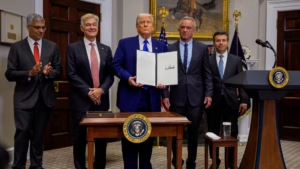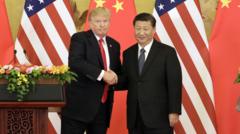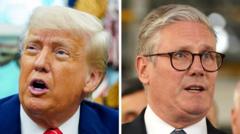This week, President Donald Trump announced an executive order designed to reform the expensive landscape of prescription drug pricing in the U.S. The order presents a clear choice for pharmaceutical companies: voluntarily lower their prices within 30 days or be mandated to match the lowest drug prices available in other developed nations.
Trump's Executive Order Aims to Lower Prescription Drug Prices

Trump's Executive Order Aims to Lower Prescription Drug Prices
In a significant move, President Trump signals a fight against high pharmaceutical costs by issuing an ultimatum to drug companies.
Targeting long-standing price discrepancies, the administration aims to alleviate the financial burden faced by American consumers, especially those who have been paying excessively for medications in comparison to prices in Europe and Canada. Trump has continually criticized the pharmaceutical sector, labeling it one of the most powerful yet unaccountable industries in America.
Proponents of the order view it as a necessary and fiscally prudent response to an escalating healthcare crisis. With prescription drug costs outpacing wage growth, particularly impacting seniors and low-income households, calls for reform have intensified. This order circumvents legislative hurdles, directly tackling what many consider a dysfunctional system.
However, opponents express concerns regarding the order's legal viability and potential implications for future drug innovations. In response, White House officials have clarified that this executive order is merely a starting point, with hints of subsequent reforms focusing on supply chain improvements and pricing transparency.
For millions of Americans facing critical decisions about their medication due to soaring costs, this executive order could signal a pivotal change in healthcare policy and represent a defining moment in the Trump administration's battle against corporate profiteering.
Proponents of the order view it as a necessary and fiscally prudent response to an escalating healthcare crisis. With prescription drug costs outpacing wage growth, particularly impacting seniors and low-income households, calls for reform have intensified. This order circumvents legislative hurdles, directly tackling what many consider a dysfunctional system.
However, opponents express concerns regarding the order's legal viability and potential implications for future drug innovations. In response, White House officials have clarified that this executive order is merely a starting point, with hints of subsequent reforms focusing on supply chain improvements and pricing transparency.
For millions of Americans facing critical decisions about their medication due to soaring costs, this executive order could signal a pivotal change in healthcare policy and represent a defining moment in the Trump administration's battle against corporate profiteering.




















